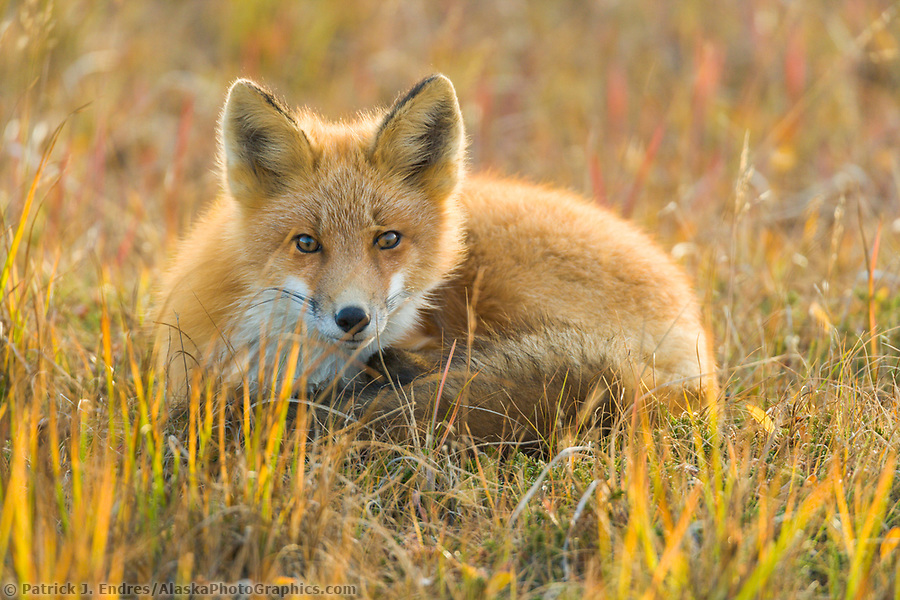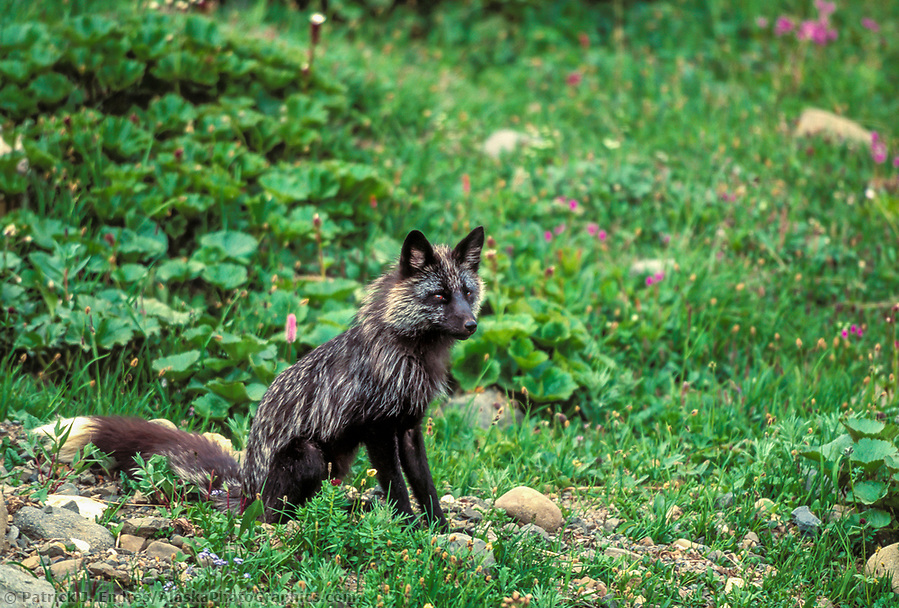Red Fox photos

Red fox stands on the autumn tundra in Denali National Park. (Patrick J. Endres / AlaskaPhotoGraphics.com)
Red fox (Vulpes vulpes)
The red fox appears in different color phases, but they are all the same species, Vulpes vulpes. They can appear black, red, silver, or various mixtures of black and red. Red foxes inhabit most of Alaska except a few southeast Alaska islands. All red fox photos on this site may be licensed as stock photography for business use or purchased as fine art pictures for home or office decor.

Red fox in the autumn grasses of wetlands on the Seward Peninsula, western Arctic, Alaska. (Patrick J. Endres / AlaskaPhotoGraphics.com)
Red fox range
The red fox is the subject of many stories, songs, fables, and parables. It is a handsome animal with a reputation for intelligence mainly due to its well-developed senses of sight, smell, and hearing. The fox prefers broken country, extensive lowland marshes, and crisscrossed hills and draws. It is most abundant south of the arctic tundra but, in recent years, has encroached further north into the tundra regions of the Arctic fox (Vulpes lagopus). The red fox is dominant where the ranges of the two species overlap.

Red Fox in Alaska’s Arctic, Atigun Pass, Brooks Range (Patrick J Endres / AlaskaPhotoGraphics.com)

Red fox in the autumn grasses of wetlands on the Seward Peninsula, western Arctic, Alaska. (Patrick J. Endres / AlaskaPhotoGraphics.com)

The red fox, Alaska mountain range, Denali State Park, Alaska

Red fox in wildflowers on Amaknak Island, Dutch Harbor, Aleutian Islands, Alaska. (Patrick J Endres / AlaskaPhotoGraphics.com)
Description
Red foxes are members of the dog family Canidae, and their general appearance is similar to dogs, wolves, and coyotes. The red fox measures 22 to 32 inches (56-82 cm) in head and body length, and the tail is 14 inches to 16 inches (35- 43 cm) long. The adult fox’s weight is from 6 to 15 pounds (2.7-6.8 kg), but it appears heavier than it is. The males, or “dogs,” are usually heavier than the females, or “vixens.”
Coloration
The red fox is usually recognized by its reddish coat, white-tipped tail, and black “stockings,” although the species has many color variations. Red is the most common color, but the hair may range from light yellowish to deep auburn red, black, silver, and mixes of all these colors. Several color phases can occur in one litter. The outside of the ears may be black-tipped, while the inside is usually white. The white tip on the tail will distinguish this fox from other species, regardless of its color phase. Red foxes are referred to by their color phase (i.e., red, cross, silver, black).

Cross fox hunts for rodents on the autumn tundra of Alaska Arctic North Slope, Brooks Range, Alaska (Patrick J. Endres / AlaskaPhotoGraphics.com)

Silver fox, one color phase of the red fox, rests in the green summer tundra of Denali National Park, Alaska. (Patrick J. Endres / AlaskaPhotoGraphics.com)

A red fox pauses while hunting on the snow-covered tundra of Alaska’s Arctic North Slope (Patrick J. Endres / AlaskaPhotoGraphics.com)

Red fox hunts for rodents in the autumn grasses of wetlands on the Seward Peninsula, western Arctic, Alaska. (Patrick J Endres / AlaskaPhotoGraphics.com)

Cross fox (red fox), Denali National Park, Alaska (Patrick J Endres / AlaskaPhotoGraphics.com)

Red fox on the snowy tundra in Alaska’s Arctic. (Patrick J Endres / AlaskaPhotoGraphics.com)
Breeding and denning
Red foxes breed during February and March. The den is a hole in the earth, 15 to 20 feet long, usually located on the side of a knoll. It may have several entrances. Sometimes foxes dig their dens. More often, though, they appropriate and enlarge the homesites of small burrowing animals, such as marmots. They also will use abandoned wolf dens. Within the den is a grass-lined nest where kits are born after a gestation of 53 days. At birth, kits weigh about 4 ounces. The young leave the den for the first time a month later. The mother gradually weans them, and they learn to hunt by the time the kits are three months old. Both parents care for the young. The family unit endures until autumn when it breaks up, and each animal is on its own.
Food
The red fox is omnivorous. Although it might eat muskrats, squirrels, hares, birds, eggs, insects, vegetation, and carrion, voles seem to be its preferred food. Fox will cache excess food when the hunting is good. They return to these storage sites and have been observed digging up a cache, inspecting it, and reburying it in the same spot. They want to be sure that their food is still there.

Red fox at a den site with kits, Denali National Park, Alaska (Patrick J. Endres / AlaskaPhotoGraphics.com)

Red fox returns from a hunt with a ground squirrel, red squirrel, and snowshoe hare crammed in the mouth, Denali National Park, Alaska (Patrick J. Endres / AlaskaPhotoGraphics.com)
Text adapted from the Fish and Game Wildlife notebook series
